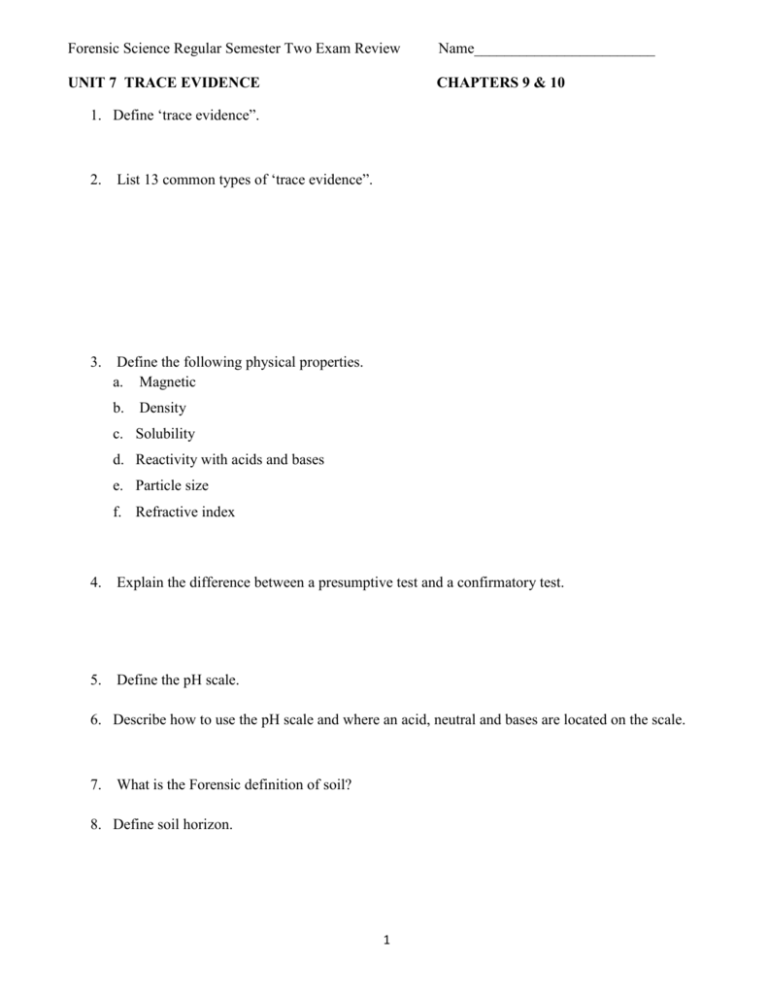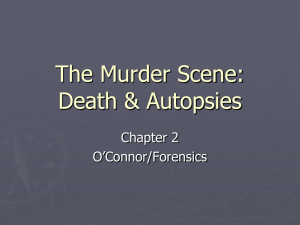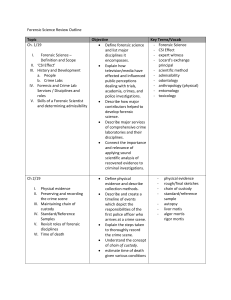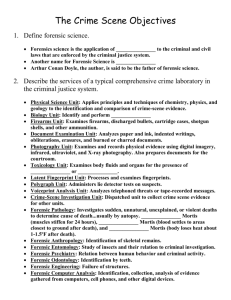Forensic Science Regular Exam Review Sem 2
advertisement

Forensic Science Regular Semester Two Exam Review Name________________________ UNIT 7 TRACE EVIDENCE CHAPTERS 9 & 10 1. Define ‘trace evidence”. 2. List 13 common types of ‘trace evidence”. 3. Define the following physical properties. a. Magnetic b. Density c. Solubility d. Reactivity with acids and bases e. Particle size f. Refractive index 4. Explain the difference between a presumptive test and a confirmatory test. 5. Define the pH scale. 6. Describe how to use the pH scale and where an acid, neutral and bases are located on the scale. 7. What is the Forensic definition of soil? 8. Define soil horizon. 1 Forensic Science Regular Semester Two Exam Review 9. Name________________________ Explain how particle size, density and refractive index are analyzed. 10. Briefly describe the “Coors Kidnapping”. 11. What was the key piece of evidence in the Coors case and where was it located? 12. What is the natural color of glass? 13. What type of evidence is glass (individual or class)? 14. Various colors of glass depend upon what elements are in the glass. Give 3 different examples of this. 15. Define the “Becke Line”. 16. Explain the difference between “radial fractures” and “concentric fractures”. 17. Explain how these fractures can be used to determine the direction and order of fractures. 18. Make a simple drawing of both radial and concentric factures. 2 Forensic Science Regular Semester Two Exam Review UNIT 8 DRUGS and TOXICOLOGY Name________________________ CHAPTERS 7 & 8 1. Using “Appendix A” summarize briefly the DEA’s “Schedule of Controlled Substances”. 2. Define the following types of illicit drugs and give examples. a. Hallucinogens b. Stimulants c. Narcotics d. Depressants 3. Define “Spot Test”. 4. What spot test are used for: a. Marijuana b. LSD c. heroin d. barbiturates 5. Define the following “Confirmatory Tests”. a. Spectrophotometery b. Chromatography (TLC, GC, LC and HPLC) 6. Who is considered the “Father of Toxicology”? 7. What is toxicity and what does LD50 mean? 8. List the major sources of lead which can create ‘lead poisoning’. 3 Forensic Science Regular Semester Two Exam Review Name________________________ 9. How does lead poisoning affect a person? 10. Give a brief description of the Georgi Markov case including cause of death and how it was administered. 11. What type of drug is alcohol? 12. What type of drug is caffeine? 13. List the factors that affect Blood Alcohol Content (BAC)? 14. Give two examples of a field sobriety test. 15. Explain how is alcohol is metabolized. 16. What ‘gas law’ is the basis for Breath-Testing instruments? 17. What chemical reaction occurs in the breathalyzer? 18. Explain how the breathalyzer works. UNIT 9 FORENSIC ENTOMOLOGY 1. Chapter 13 Define the following terms: a. Livor mortis b. Algor Mortis c. Rigor Mortis 2. What does PMI stand for? 4 Forensic Science Regular Semester Two Exam Review Name________________________ 3. How does each of the following relate to PMI? a. Livor mortis b. Algor mortis c. Rigor mortis 4. Write the formula for the Glaister equation. 5. Calculate the following problem using the Glaister equation: The body temperature of a body was found to be 89 degrees F. What is the PMI? 6. Fill in the following chart: Temperature of the Body Stiffness of the Body Warm Not stiff Warm Stiff Cold Stiff Cold Not Stiff Time Since Death (give an aprox. time range) 7. Define the following terms: a. Autolysis b. Putrefaction c. Black putrefaction d. Butyric fermentation e. Diagenesis (dry decay) UNIT 10 BLOOD and DNA Chapter 11, 12 1. What is serology the study of? 2. What type of evidence is blood typing? 3. What type of evidence is DNA? 4. What would you use to determine if a stain is blood? 5. What would you use to determine if a blood stain is human or animal? 5 Forensic Science Regular Semester Two Exam Review 6. Name________________________ What is the purpose of the Kastle-Meyer test? 7. What did Karl Landsteiner contribute to Forensic Science? 8. What did Leon Lattes contribute to Forensic Science? 9. Fill in the following chart for Blood Factors: Blood Type Antigen Antibody A Donor for Recipient for B B B, AB AB AB A and B O 10. Define the following terms: a. Agglutinate b. Plasma c. Serum d. Secretors 11. Define the following blood spatter terms: a. Low velocity b. Medium velocity c. High velocity d. Passive drops e. Satellite drops 6 Forensic Science Regular Semester Two Exam Review Name________________________ Based on the lab 11.4 Blood Pattern Analysis, answer the following questions. 12. Calculate the angle of impact for the bloodstains below: See pg 330, Question 15 in your book. Fill in the following information. W_________ W_________ W_________ I___________ I___________ I___________ Angle_______ Angle_______ Angle_______ A. B. C. W_________ I___________ Angle_______ D. W_________ W_________ I___________ I___________ Angle_______ Angle_______ E. F. 13. Define the following terms: a. Chromosomes b. DNA c. Genes d. Hydrogen bonds e. Amino acids f. Restriction enzymes g. Electrophoresis h. PCR i. STR j. CODIS k. MtDNA 14. Describe what process would be used to amplify (make numerous copies) DNA. 15. How many chromosomes does a human have? 16. How many genes does a human have? 7 Forensic Science Regular Semester Two Exam Review Name________________________ 17. What are the four nitrogen bases found in DNA? 18. Match up the following base pairs: a. A ________ b. T_________ c. G ________ d. C_________ 19. Briefly explain the Green River Killer case study. a. How was Green River Killer finally caught? b. Who is the Green River Killer? UNIT 11 FORENSIC ANTHROPOLOGY Chapter 14 1. Define the following terms: a. Anthropology b. Osteology c. Osteon d. Suture 2. List the four classifications of bones. Give 3 example of each. 3. What can you determine about an individual by examining their bones? 4. What specific bones are examined to determine gender? 5. What particular structure of a bone is examined to determine if a bone is animal? human? 6. What is the purpose of facial reconstruction? 8






